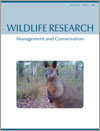Context. Avian–human conflict is a growing issue in urban areas, yet studies of conflict tend to be species and situation specific and focus on landscape characteristics that generate or exacerbate the problem.
Aims. To determine characteristics of bird species that cause conflict in urban areas within their native range and to develop a model that can be used to assess the relative likelihood of a New Zealand species causing conflict in the future.
Methods. Ecological, behavioural and life-history characteristics of 33 conflict-causing species identified from the literature and 106 randomly selected non-conflict congeners were compared using an information-theoretic approach to multi-model selection and inference. Variables from the confidence set of models were used to develop a model that was applied to the New Zealand urban avifauna to provide a relative measure of a species’ potential to generate conflict.
Key results. A model including only dietary breadth best explained the conflict (ωi = 0.833). Using dietary breadth, flocking, clutch size, granivory, territoriality and non-ground nesting – the confidence model set – New Zealand’s native pukeko (Porphyrio porphyria), red-billed gull, (Larus scopulinus), and kākā (Nestor meridionalis) were identified as the three species most likely to generate conflict with urban residents.
Conclusions. Broad dietary requirements may allow a species to take advantage of novel and varied food sources in the urban environment and lead to population growth. Large populations at high density may amplify problems, exceeding residents’ tolerance levels and resulting in conflict. Species characteristics relating to nesting, sociality and body size were found to be uninformative.
Implications. Species with a broad diet, particularly those identified by this study as having a high potential for conflict, should be the focus of monitoring to identify population growth and the emergence of problems in urban areas. This will allow proactive implementation of management, improving the likelihood of conflict mitigation.





